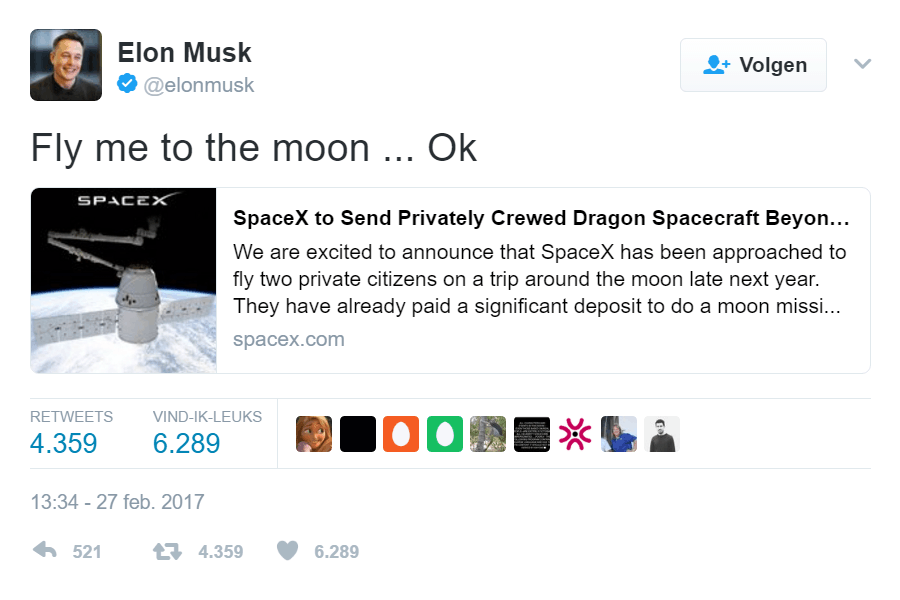| SpaceX to Send Privately Crewed Dragon Spacecraft Beyond the Moon Next Year | |
| We are excited to announce that SpaceX has been approached to fly two private citizens on a trip around the moon late next year. They have already paid a significant deposit to do a moon mission. Like the Apollo astronauts before them, these individuals will travel into space carrying the hopes and dreams of all humankind, driven by the universal human spirit of exploration. We expect to conduct health and fitness tests, as well as begin initial training later this year. Other flight teams have also expressed strong interest and we expect more to follow. Additional information will be released about the flight teams, contingent upon their approval and confirmation of the health and fitness test results. Most importantly, we would like to thank NASA, without whom this would not be possible. NASA’s Commercial Crew Program, which provided most of the funding for Dragon 2 development, is a key enabler for this mission. In addition, this will make use of the Falcon Heavy rocket, which was developed with internal SpaceX funding. Falcon Heavy is due to launch its first test flight this summer and, once successful, will be the most powerful vehicle to reach orbit after the Saturn V moon rocket. At 5 million pounds of liftoff thrust, Falcon Heavy is two-thirds the thrust of Saturn V and more than double the thrust of the next largest launch vehicle currently flying. Later this year, as part of NASA’s Commercial Crew Program, we will launch our Crew Dragon (Dragon Version 2) spacecraft to the International Space Station. This first demonstration mission will be in automatic mode, without people on board. A subsequent mission with crew is expected to fly in the second quarter of 2018. SpaceX is currently contracted to perform an average of four Dragon 2 missions to the ISS per year, three carrying cargo and one carrying crew. By also flying privately crewed missions, which NASA has encouraged, long-term costs to the government decline and more flight reliability history is gained, benefiting both government and private missions. Once operational Crew Dragon missions are underway for NASA, SpaceX will launch the private mission on a journey to circumnavigate the moon and return to Earth. Lift-off will be from Kennedy Space Center’s historic Pad 39A near Cape Canaveral – the same launch pad used by the Apollo program for its lunar missions. This presents an opportunity for humans to return to deep space for the first time in 45 years and they will travel faster and further into the Solar System than any before them. Designed from the beginning to carry humans, the Dragon spacecraft already has a long flight heritage. These missions will build upon that heritage, extending it to deep space mission operations, an important milestone as we work towards our ultimate goal of transporting humans to Mars. - SpaceX - 27-02-2017 | |
 | |
Ruwe timeline: Q2 2017: Eerste vlucht Falcon Heavy Q4 2017: Crew Dragon onbemand naar ISS op Falcon Heavy Q2 2018: Crew Dragon bemand naar ISS op Falcon Heavy Q4 2018: Crew Dragon met twee bemanningsleden richting maan De Raket: SpaceX zal haar Falcon Heavy gaan gebruiken voor deze maanmissie. Deze raket is een doorontwikkeling van de Falcon 9 en moet deze zomer voor het eerst de lucht in gaan. Het wordt de meest krachtige raket die op dit moment operationeel is. | |
 With more than 5 million pounds of trust at liftoff, Falcon Heavy will be the most capable rocket flying. By comparison, the liftoff thrust of the Falcon Heavy equals approximately eighteen 747 aircraft at full power. Below is a comparison chart of the world’s heavy lift vehicles, based on historical launch data. Falcon Heavy can lift the equivalent of a fully loaded 737 jetliner--complete with passengers, luggage and fuel--to orbit. Only the Saturn V moon rocket, last flown in 1973, delivered more payload to orbit than Falcon Heavy.  Media: | |
[ Voor 24% gewijzigd door Balance op 27-02-2017 23:31 ]
:strip_icc():strip_exif()/u/496922/Balance%252060x60.jpg?f=community)

:strip_exif()/u/77369/crop5c9e19bb76f02_cropped.gif?f=community)
:strip_icc():strip_exif()/u/44113/tux.jpg?f=community)
:strip_icc():strip_exif()/u/75091/cgl213_rage_face.jpg?f=community)
/u/560489/crop578488a2c3c46.png?f=community)
:strip_icc():strip_exif()/u/145751/check-in-minion-small2.jpg?f=community)
/u/46804/crop5f989efcbb253.png?f=community)
:strip_exif()/u/23102/anandus.gif?f=community)
:strip_exif()/u/259931/stuiterbal2.gif?f=community)
/u/402578/crop5742bc32a9504_cropped.png?f=community)
/u/36403/Mobile_Map.png?f=community)


/u/151049/crop56fd486483c96.png?f=community)
:strip_exif()/u/15441/cat.gif?f=community)
/u/12852/Xykon_klein.png?f=community)
/u/221823/crop5db1c1f284bca_cropped.png?f=community)
:strip_icc():strip_exif()/u/143607/naze60.jpg?f=community)

/u/342375/crop5e13205150e40_cropped.png?f=community)
:strip_icc():strip_exif()/u/204309/goron.jpg?f=community)
:strip_icc():strip_exif()/u/709413/crop5a880be8806d7_cropped.jpeg?f=community)

:strip_icc():strip_exif()/u/49846/bill2.jpg?f=community)